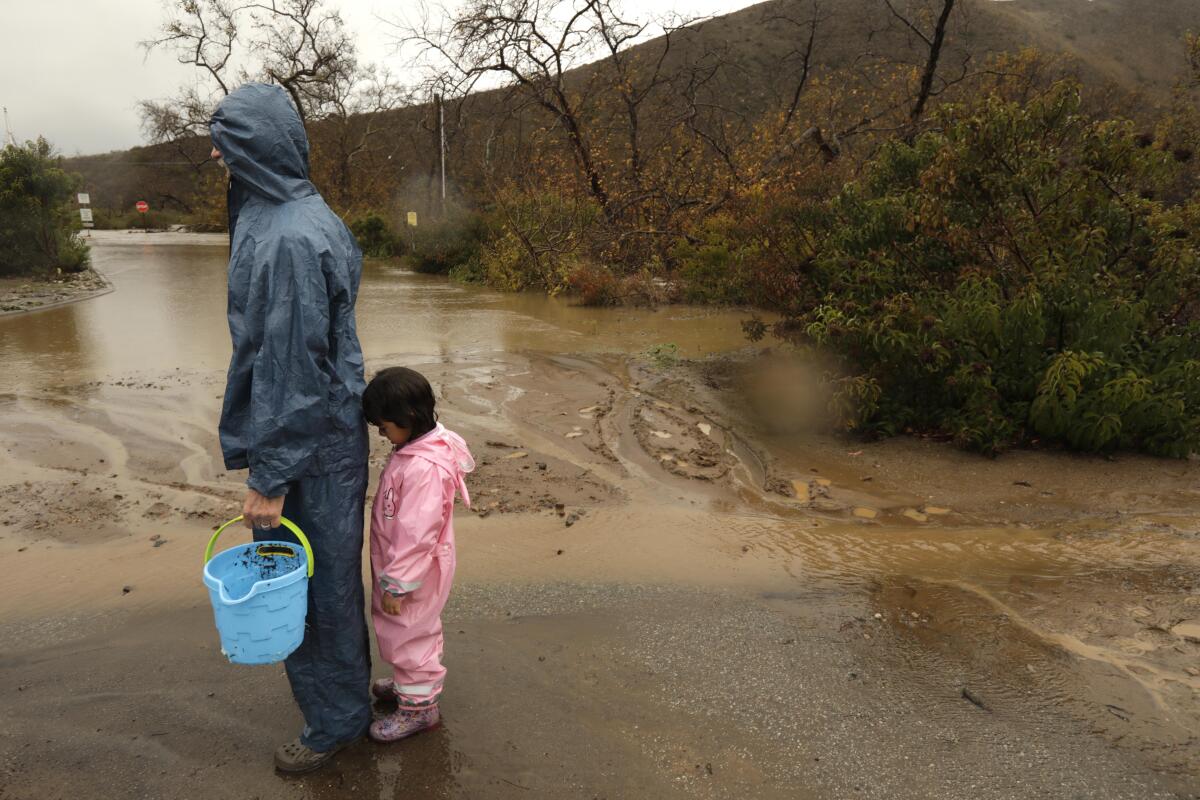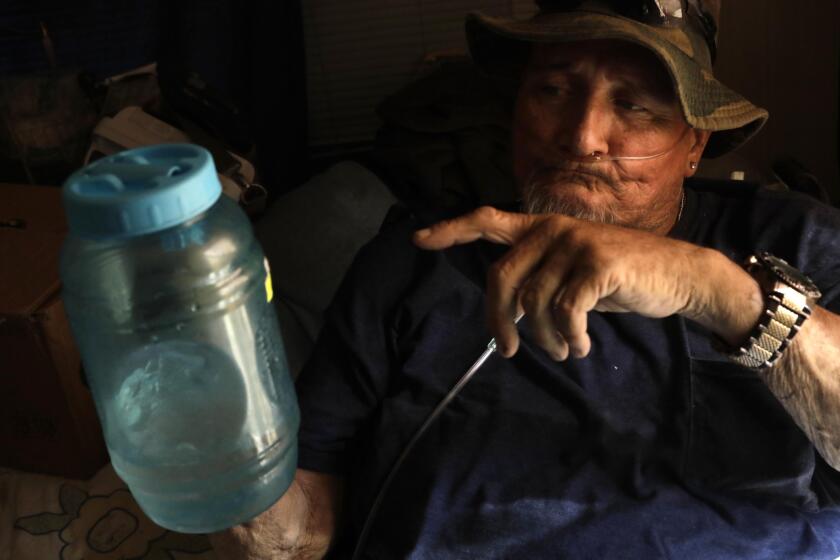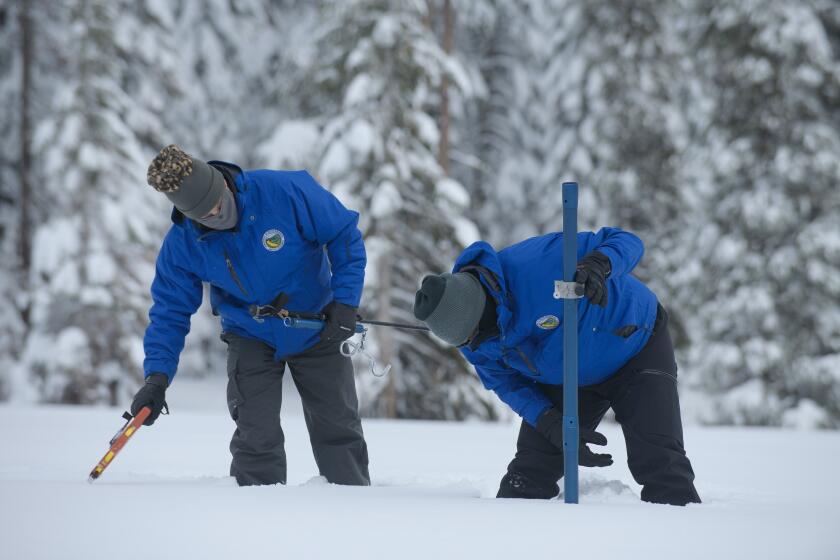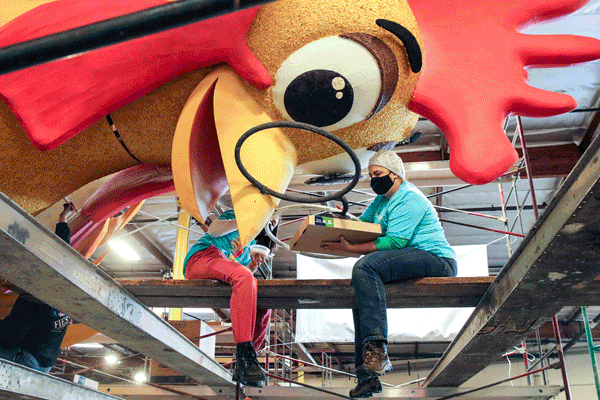California’s very dry year ends with some chaos, some relief in heavy rain and snow

- Share via
A year characterized by drought, wildfire and water restrictions in California ended not with more dryness but with a deluge.
Back-to-back storms dumped about 7 inches of rain in downtown Los Angeles in December, more than tripling the month’s normal rainfall of 2.03 inches and placing it in the 10 wettest Decembers on record, the National Weather Service said.
The L.A. River, reduced to a near trickle during a bone-dry November, surged to nearly 10 feet in some areas Thursday, while a flash flood in Malibu hamstrung at least 50 campers who had to be rescued from raging muddy waters.
Inside downtown L.A.’s Union Station, a crew of workers used squeegees to push water toward several pumps after a central passageway flooded with several inches of water.
The 2.34 inches of rain in downtown L.A. broke a daily record set in 1936 as the storm led to flash floods, debris flows and closed highways and roads.
“It’s terrible. And it can be dangerous if you slip,” said Frances Green, walking gingerly toward her train for Palmdale. She makes the trip several times a month and said: “I have never seen this before.”
For many residents, it was one of the soggiest months in recent memory. But when it comes to ending the drought, experts say there’s still a long way to go and a massive deficit to make up for. The 2021 water year, which ended Sept. 30, was the state’s driest in a century.
“It takes a long time to get into a drought of this severity, and there’s no quick fix,” said Bill Patzert, a retired climate scientist at NASA’s Jet Propulsion Laboratory. “You crawl in, and you creep out.”
The year saw reservoirs across the region shrink to historic lows, including Lake Mead — a lifeline for water in the West. Wildfires, fueled by drought-dried vegetation, consumed more than 2.5 million acres across California, and major heat waves killed hundreds of people.
Read all of our coverage about how California is neglecting the climate threat posed by extreme heat.
Conditions became so dire that officials in August had to shut down a major hydroelectric power plant at Lake Oroville for the first time since its completion in 1967 on account of low water.
Patzert said the rainy December came as a welcome surprise after seasonal outlooks issued by the National Oceanic and Atmospheric Administration favored a drier-than-normal winter, but whether the coming months will follow suit depends on La Niña conditions, the presence of a high-pressure system off the coast and other factors.
“Hopefully the forecast is not only a bust for December — I’d like to see them fail in January, February and March as well,” he joked.
Though drought conditions persist, the month’s storms gave a boost to the state’s water supplies, which have suffered this year. In October, Gov. Gavin Newsom declared a statewide drought emergency and urged residents to conserve water.
Earlier this month, officials said California’s water agencies might get 0% of their requested allocations from the state due to limited supplies.
But on Thursday, officials with the California Department of Water Resources conducted the first snow survey of the season at Phillips Station near South Lake Tahoe and found that the spectacularly stormy December brought the state’s mountain snowpack to about 160% of average for this time of year.
“We are off to a great start,” said Sean de Guzman, manager of snow surveys for the Department of Water Resources. “We need more of these storms to keep coming through.”
Storms in December pushed California snowpack to 160% of average, giving a boost to the state’s drought-depleted water supplies.
The survey came amid record-breaking snow in the Sierra Nevada. The UC Berkeley Central Sierra Snow Lab at Donner Pass received more than 17 feet of snow this month, its third-snowiest December on record.
The region’s reservoirs also saw a boost. The water level in Lake Oroville was 38% of normal Thursday, up from about 33% one week earlier, according to state data.
Still, De Guzman said, the state is “definitely not out of the woods.”
In addition to delivering much-needed moisture, the latest storm packed a wallop as it moved through California.
Tens of thousands of residents in the Sierra were without power Thursday, according to Pacific Gas & Electric Co., and officials were pleading with residents to stay off the snow-covered roads, including Highways 50 and 80. Newsom declared a state of emergency in 20 counties to assist with response and recovery efforts from the storms.
California Department of Transportation Director Toks Omishakin said the winter storms in the Sierra have caused more than $22 million in damage so far.
Crews were working in 12-hour shifts around the clock to keep the roads passable for essential travel, Omishakin said in a video update.
“If it’s a trip just to hang out with family and friends, we’re saying stay off the roads,” he said. “The conditions are treacherous.”
There was little respite from the weather in Los Angeles, where the slow-moving storm came to a near halt over the area for much of the day.
“Most storms we get six hours of rain and it’s through, but this particular situation is different,” said Mike Wofford, a meteorologist with the National Weather Service in Oxnard. “The low pressure sitting off the coast is not really moving; it’s just kind of funneling moisture into our area.”
Preliminary weather service data suggested daily rainfall records were broken at nine locations in the Greater L.A. area, including 2.34 inches in downtown L.A. that toppled an 85-year-old record. Final precipitation totals were not available Thursday night.
The snow comes as a much-needed surprise for the bone-dry West, where only months ago, officials put residents under a state of drought emergency.
The cold, wet weather made life on the streets more dreary and dangerous. The Los Angeles Homeless Services Authority activated an extra 30-bed homeless shelter in Glassell Park from Wednesday night through Saturday morning because of the weather.
One man, Joe Currin, was staying mostly dry, his tent wedged beneath an overpass along the L.A. River bike path in Los Feliz. As he worked the Los Feliz Boulevard exit from the 5 Freeway, he said he found the weather had a silver lining.
“I was out there for less than an hour and I got $48,” Currin said. “People are pretty generous.”
The National Weather Service issued several advisories across the Southland, including winter storm warnings in the mountains of Ventura, Los Angeles and San Bernardino counties, and flash flood watches and voluntary evacuation warnings for residents near wildfire burn scars.
Near the scene of last year’s Bobcat fire in Monrovia, streets and homes were holding their own Thursday.
North Canyon Boulevard, above the Sawpit Debris Basin, remained closed after a washout a few weeks back. But there was no discernible new damage to the mountain roadway, and water and debris in Monrovia Canyon remained about 10 feet below where it was in the earlier storm.
“We’ve fared really well. We feel fortunate,” said Denise Valazza, whose home overlooks the canyon.
Heavy rain and snow are prompting road closures and evacuations across Southern California on Thursday.
Ridgeside Drive, Oakglade Drive and other nearby streets have had sandbags and concrete barriers in place for months, but runoff remained light enough Thursday afternoon that the precautions were not needed.
Valazza and her husband, Tony, said the biggest loss will probably be access to trails in Monrovia’s Canyon Park. Redone after the Bobcat fire, the trails are likely to need more repairs after the rains.
The couple had hiked the trails as often as five days a week before the fire and flooding.
“That’s a real shame,” said Denise Valazza. “We miss it a lot.”
Others didn’t fare quite as well. Apple Valley resident Keith Elvert was camping with his wife, children, parents and niece at Leo Carrillo State Park in Malibu when the flash flood arrived.
When he opened the door to his trailer around 3 a.m. Thursday, “there was two feet of water running outside the trailer pretty swiftly,” he said.
“It was pretty scary — there were some branches and debris, and it was real muddy brown,” Elvert said. “You appreciate the power of the water at that point.”
The family grabbed what they could and evacuated by car to a hotel in Thousand Oaks. They hoped to get back to the trailer Friday or Saturday to assess the damage, he said.
The rain also made a mess of some major roadways in Los Angeles, with officials closing all lanes of the Grapevine for hours due to ice and snow.
Portions of the Pacific Coast Highway, Mulholland Highway and the Angeles Crest Highway were also closed due to mud, rocks and debris, officials said.
Some residents said they were ready for sunshine again.
“I live in a part of L.A. where you walk everywhere,” said Koreatown resident Matthew Olivarez, who typically goes to the grocery store, the bank and the train station on foot. “I like a bit of rain, but it’s enough.”
Floats are being decorated, marching bands are tuning up and thousands are bundling up to see the spectacle. But the pandemic lurks in the background.
He may get his wish: Forecasters said the storm was slated to taper off Thursday night, with only a few spotty showers possibly remaining Friday morning.
Patzert, the climatologist, noted that New Year’s Day should also be dry — something he called “the luck of the Rose Parade.” It has rained only nine out of 120 times on parade day, he said.
And though the December storms were significant for the state’s residents after a year of so much dryness, monthly totals in Los Angeles still aren’t close to breaking records, officials said.
The wettest December on record in downtown Los Angeles was in 1889, when 15.8 inches of rain fell, said Mark Jackson, a meteorologist with the National Weather Service in Oxnard.
In second place was December 2010, when 10.23 inches fell.
Jackson said 2010 could offer some clues to what the coming months may bring, since it was also a La Niña year with a wet December. But in January 2011, downtown L.A. received a scant 0.79 inches.
“It went from feast to famine in one month,” Jackson said, “and unfortunately, when we look out ahead past this storm, it looks dry all the way out through halfway through January. So this could be it for a while.”
Patzert agreed.
“We’re having a December euphoria here, but that doesn’t guarantee January, February and March,” he said. “But I think the consensus is that we’re loving the rain.”
Times staff writer Ian James contributed to this report.
More to Read
Sign up for Essential California
The most important California stories and recommendations in your inbox every morning.
You may occasionally receive promotional content from the Los Angeles Times.




















